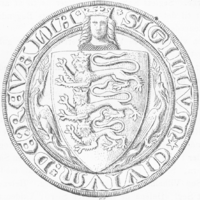
Coat of arms of Estonia
Encyclopedia


Coat of arms
A coat of arms is a unique heraldic design on a shield or escutcheon or on a surcoat or tabard used to cover and protect armour and to identify the wearer. Thus the term is often stated as "coat-armour", because it was anciently displayed on the front of a coat of cloth...
of Estonia
Estonia
Estonia , officially the Republic of Estonia , is a state in the Baltic region of Northern Europe. It is bordered to the north by the Gulf of Finland, to the west by the Baltic Sea, to the south by Latvia , and to the east by Lake Peipsi and the Russian Federation . Across the Baltic Sea lies...
is a golden shield which includes three slim blue passant gardant lions
Lion (heraldry)
The lion is a common charge in heraldry. It traditionally symbolises bravery, valour, strength, and royalty, since traditionally, it is regarded as the king of beasts.-Attitudes:...
in the middle, with oak branches along the side of the shield. The three lions derive from the arms
Coat of arms of Denmark
The royal coat of arms is more complex. The shield is quartered by a silver cross fimbriated in red, derived from the Danish flag, the Dannebrog. The first and fourth quarters represent Denmark by three crowned lions passant accompanied by nine hearts; the second quarter contains two lions passant...
of Danish
Denmark
Denmark is a Scandinavian country in Northern Europe. The countries of Denmark and Greenland, as well as the Faroe Islands, constitute the Kingdom of Denmark . It is the southernmost of the Nordic countries, southwest of Sweden and south of Norway, and bordered to the south by Germany. Denmark...
king Valdemar II
Valdemar II of Denmark
Valdemar II , called Valdemar the Victorious or Valdemar the Conqueror , was the King of Denmark from 1202 until his death in 1241. The nickname Sejr is a later invention and was not used during the King's own lifetime...
who had conquered northern Estonia in 1219. The lions became part of the greater coat of arms of Tallinn
Coat of arms of Tallinn
Coat of arms of Tallinn is the coat of arms of the Estonian capital Tallinn. Tallinn is located in Harju County, Estonia.- Greater coat of arms :...
, the center of Danish government in Estonia, and the knightages (ger
German language
German is a West Germanic language, related to and classified alongside English and Dutch. With an estimated 90 – 98 million native speakers, German is one of the world's major languages and is the most widely-spoken first language in the European Union....
. ritterschaften) of Harria and Viru
Viru
Viru is a 5.0% ABV pilsner-style beer brewed in Estonia. It is brewed in the country's second largest city, Tartu, by the A. Le Coq brewery. The brand is owned by Baltic Beer Company Ltd , based in London, UK, and is brewed under licence in Estonia. A...
. In 1346, Denmark sold its Estonian dominion to the Teutonic Order after its power had been severely weakened during the St. George's Night Uprising
St. George's Night Uprising
St. George’s Night Uprising in 1343–1346 was an unsuccessful attempt by the indigenous Estonian population in the Duchy of Estonia, the Bishopric of Ösel-Wiek, and the insular territories of the State of the Teutonic Order to annihilate the Danish and German rulers and landlords, who had conquered...
of 1343-1346. The three lions, however, remained the central element of the greater coat of arms of Tallinn. In later centuries, the motif of the three lions transferred to the coat of arms of the Duchy of Estonia
Swedish Estonia
The Duchy of Estonia , also known as Swedish Estonia, was a dominion of the Swedish Empire from 1561 until 1721, when it was ceded to Russia in the Treaty of Nystad, following its capitulation in the Great Northern War. The dominion arose when the northern parts of present-day Estonia were united...
, the Ritterschaft of Estland, and to the coat of arms of the Governorate of Estonia
Governorate of Estonia
The Governorate of Estonia or Estland, also known as the Government of Estonia or Province of Estonia, was a governorate of the Russian Empire in what is now northern Estonia.-Historical overview:...
.
The Riigikogu
Riigikogu
The Riigikogu is the unicameral parliament of Estonia. All important state-related questions pass through the Riigikogu...
(the state assembly) of the independent Republic of Estonia officially adopted the coat of arms on June 19, 1925.
The coat of arms was officially banned following the occupation of Estonia by the Soviet Union
Soviet Union
The Soviet Union , officially the Union of Soviet Socialist Republics , was a constitutionally socialist state that existed in Eurasia between 1922 and 1991....
in 1940, and replaced with the Soviet-inspired coat of arms of the Estonian SSR
Coat of arms of the Estonian SSR
The coat of arms of the Estonian SSR was adopted in 1940 by the government of the Estonian SSR. It features a sunrise accented by sunbeams, the hammer and sickle for the victory of communism and the "world-wide socialist community of states", and the red star to represent the affiliation to...
. Soviet officials persecuted and jailed anyone using the coat of arms or the national colors of Estonia. The readoption of the national symbols marked the completion of the struggle for independence which was finally achieved on August 7, 1990, and regulated by the Law on State Coat of Arms of April 6, 1993.

